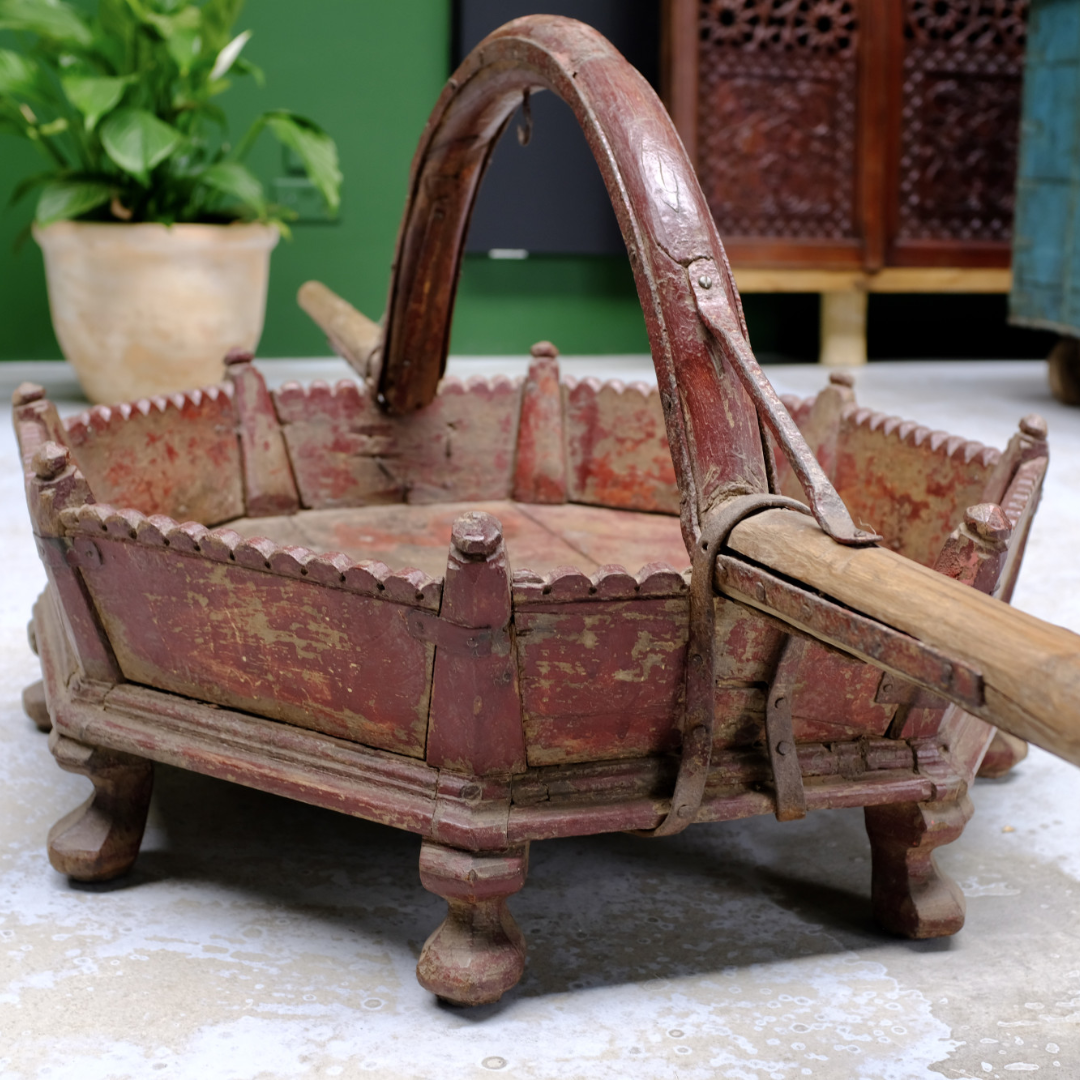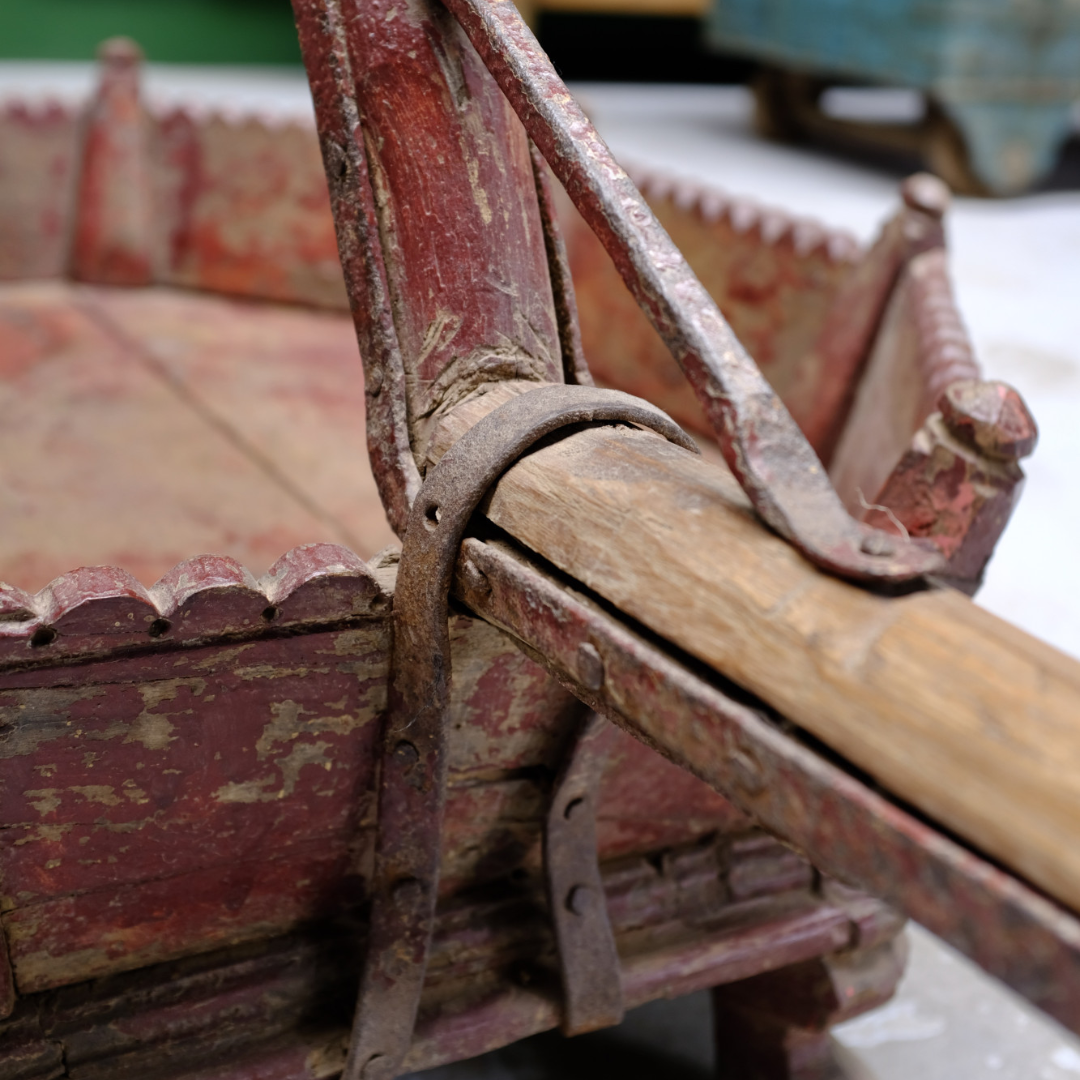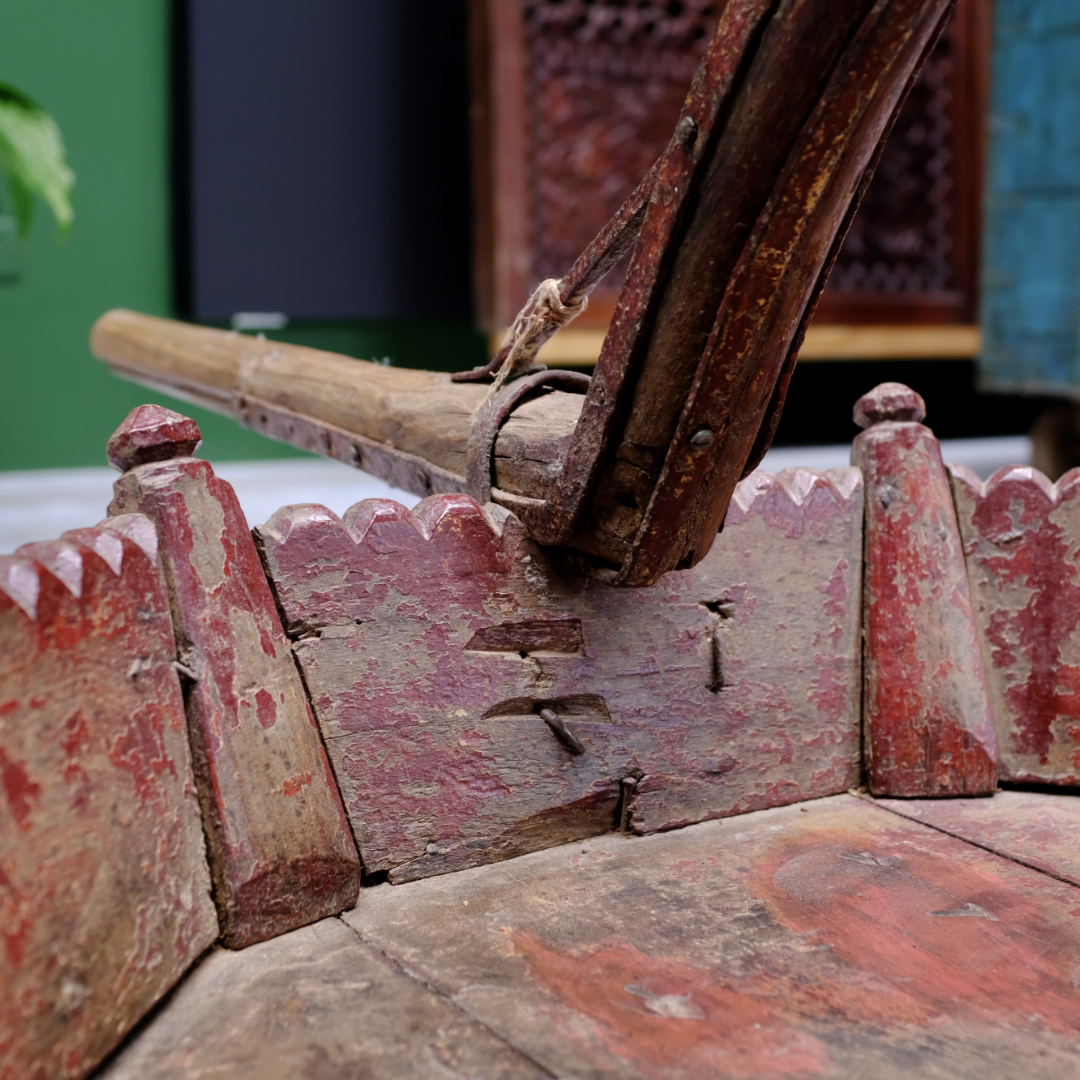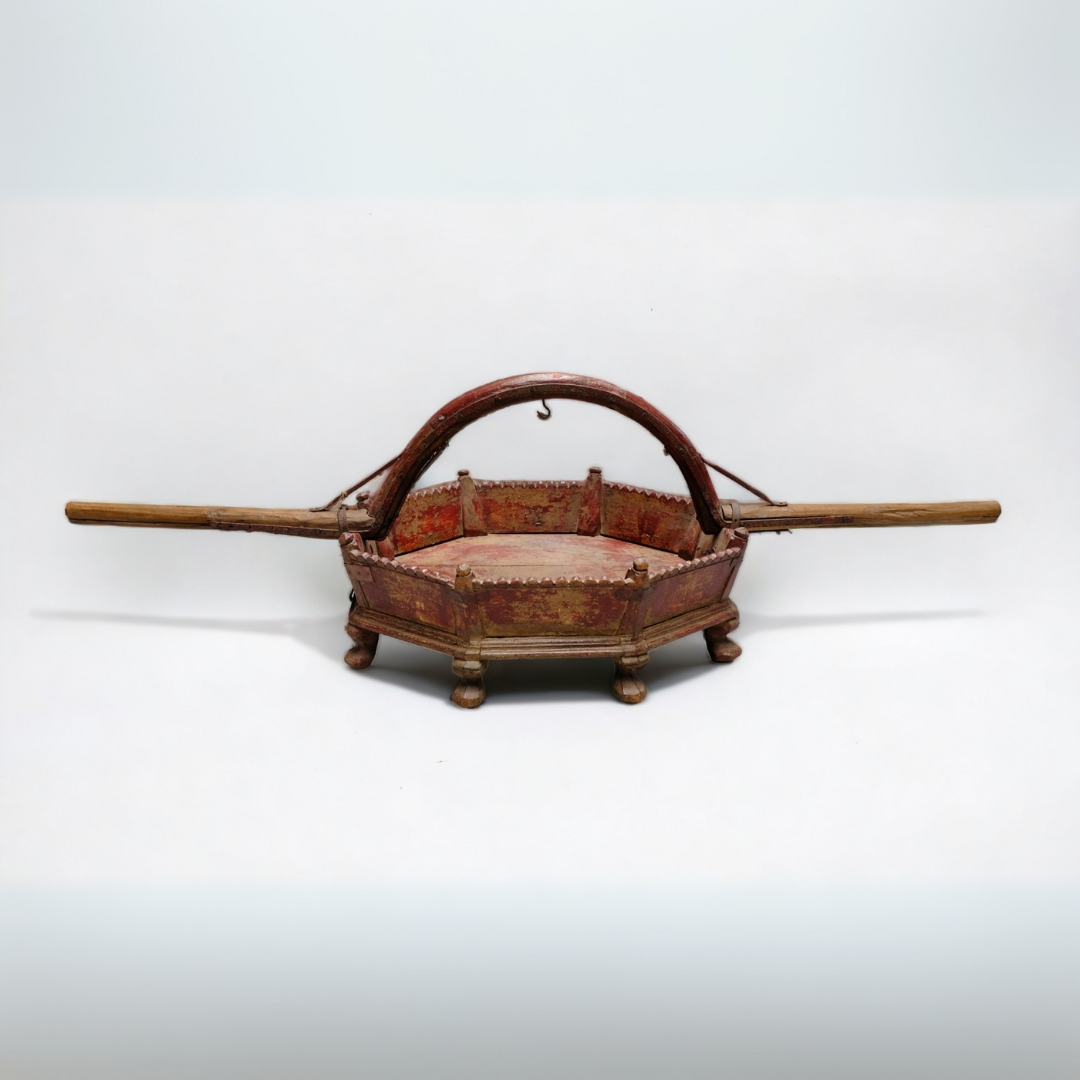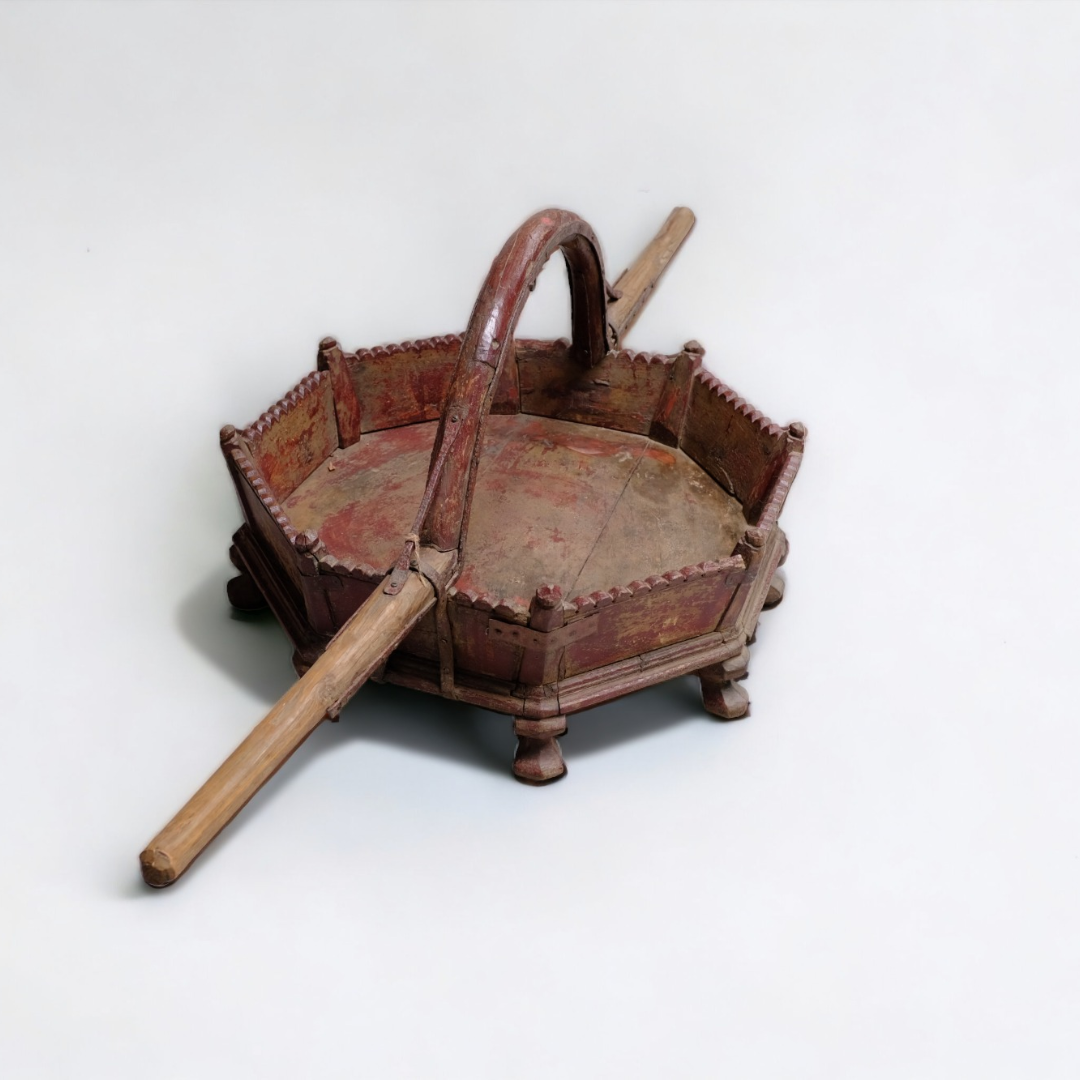
Price
Materials
Period
Place of origin
SKU
Dimensions
Available Stock: 1
About the product
Antique Indian Teak Wood Palanquin (Palki), Circa 1900
This beautiful, painted Palki or Palanquin is hand-made of teak wood and iron and was a traditional mode of transportation used in India.
The name is derived from the Sanskrit word "Palayanka,” meaning bed. It is a wooden seat mounted on two sets of poles and is either open or enclosed, carried on the shoulders by several bearers. As this piece is much smaller it would have transported revered deities, idols, or spiritual figures during religious processions or festivals.
The Palki structure sits on top of eight bun-style feet, the shell edge design is simple yet elegant, and the wrought iron straps across the handles and the top arch, reinforce the structure. The now antique and distressed red colour represents love, passion, and fertility. The colour is widely used during weddings and other auspicious occasions.
Palki (pallaku), or palanquin, is a traditional mode of transportation used in India. The name is derived from the Sanskrit word "Palayanka,” meaning bed. It is a wooden seat mounted on two sets of poles. A palki is either open or enclosed and is carried on the shoulders by several bearers known as bearers or kahaars.
The construction of a palki varies in shape and size, in accordance with its use. A palki, made to be used by a bride, was borne by two bearers and is called a palki doli, dhooly, or dhoolie, while palkis of a larger size, constructed to be used as a mode of transportation by kings, royalty, aristocrats, or even affluent people of society for shorter or longer travels, used six to eight bearers, but all in an even number. These palki can be an open seat or chair mounted atop the wooden poles and used by kings or royalty for shorter distances, or they could be a spacious coach made for long travel that was beautifully decorated in gold and silver and enclosed to provide the occupant shelter from dust, rain, or the sun, providing all the facilities required in the long and arduous journey.
Ibn Battuta has mentioned the use of palki by the kings and his kinsmen during his travels through India. These palkis spoke of the grandeur of the occupant and were carried by eight bearers who used to work alternatively in a shift of four to provide the necessary rest for the other bearers. The palki was even a preferred mode of transportation by an affluent section of society, and the bearers could be found near bazaars or the gates of homes expecting to be hired.
Traditionally, palki was used by kings, members of the royal family, or other members of influential sections of society to travel comfortably over short or long distances. In the Ramayana, we find the earliest mention of the use of palki when Rama is carried on it during his coronation as the crown prince. Various Indian paintings and sculptures also depict the palki being used as a mode of transportation by affluent and aristocratic members of society.
Palkis remained an important mode of transportation even after the introduction of motor-powered vehicles. European traders in the 17th and 18th centuries, and later even the officials of the English East India Company, used palki for visiting haats and bazaars and transporting their cargo. They even kept staff to maintain their personalised palki.
By the turn of the 19th century, even the postal department started using palki, which was hired to carry mail, and the bearers were recruited to work as carriers. The postal department even started the Palki service for travellers who were charged similarly to the modern transportation system. The palki was accompanied by a team of bearers, which consisted of two torch-bearers, two porters for luggage, and eight bearers who worked alternatively in groups of four to complete the journey straight through or with breaks as per convenience.
In the 19th century, with the arrival of motor-powered vehicles and other developments in modern ways of transportation like steamers and railways, the palki fell out of favour as the preferred mode of transportation but was still in use by the aristocratic families, which became a symbol of their social status. These palki were mostly used to provide necessary purdah to the travelling women and had shutters and curtains.
The ornamentation and grandeur of a palki were used to reflect the affluence of the owner. The exterior of a palki was ornamented with gold and silver and covered in silk to provide a majestic look. The interiors were furnished with pillows and provided amenities for reading, writing, eating, and sleeping for the comfort of the traveller. The bearers working in tandem would often sing or hum during the journey to break the monotony of the journey. These palki became ideal for travelling across rough terrain.
Over time, the palki started to be used as a mount for a temple or village deity. The origin of this tradition is in obscurity, but references can be found in Puranas, where Kubera (King of Yakshas and God of Wealth) is said to travel across the realm over his palki. In Hindu tradition, the use of palki is to carry a deity in a ritual procession. The palki can contain a mohar (image) of the deity, a guru (spiritual or ascetic leader), his padukas (sandals), or any other possessions related to the deity or the guru. The belief in carrying a deity on a palki symbolizes the divine moving among the devotees and blessing them.
The movement of the ratha (chariots) of the deities can be cumbersome, and it usually takes place on special occasions like the ratha yatra of Puri (in the state of Odisha), when the three massive ratha of Lord Jagannatha, Balbhadra, and Subhadra move for a week from their abode at Jagannatha temple. Unlike such ratha, which moves along a designated path due to the massiveness of their building, the palki enables the deities to be present at any location, interact with them, and bless them. The presence of God among the devotees generates a feeling of reverence and a connection with him.
In villages, the religious festivals centre around the palki of the deity, who governs every aspect of the lives in the villages. These palkis are made from the wood of the forests that these deities govern. Taking the wood from the forests, which are guarded by other deities, is treated as a serious transgression.
The image of the deities were made of gold, silver, or any of their alloys and were seated on the palki, which is dressed in traditional costumes and ornaments, unique with respect to the palki of other deities. The people pray for good health, good crop, production, and a timely and adequate amount of rain, as it is believed that deities have control over these aspects. The deities bless the devotees in the form of flowers, dry fruits, or any other form of prasad from the palki.
In the Himalayan states of India, it is believed that deities sleep during the periods of Shravan (July–August) and Kartik (October–November) and visit swarg (heaven) during the winters, so this is the period when any kind of repair or modification of palki is done.
India is a vast land with variations in traditions, the palki procession also has varying meanings depending on the region. Today, the palki is not used as a chosen mode of transportation and has lost its appeal as a symbol of one’s prosperity. But palki is still relevant in religious and cultural processions and is still designed following the history and culture of the area concerned. The religious festivals and gatherings are still centred on the importance of the palki of the presiding deity.

